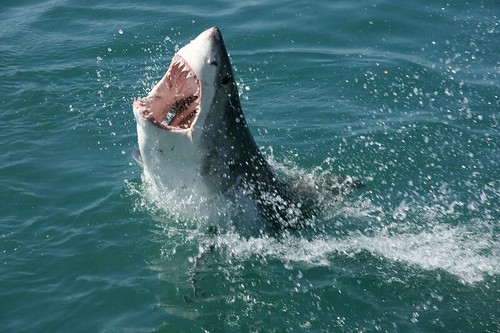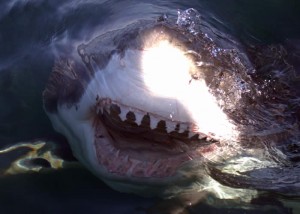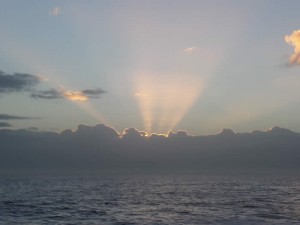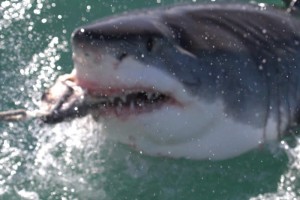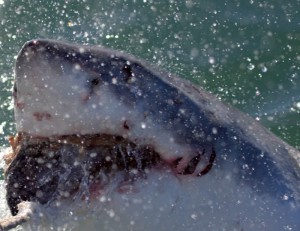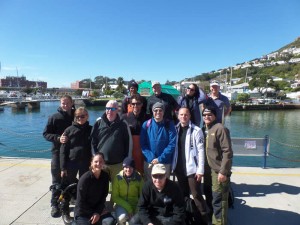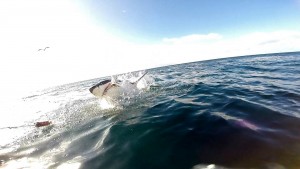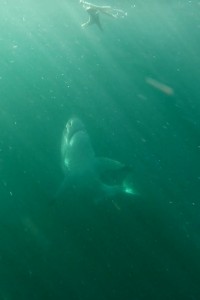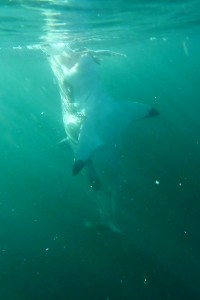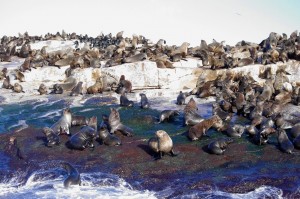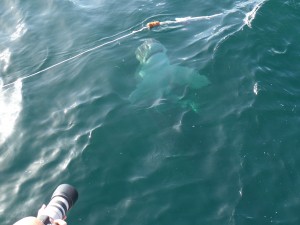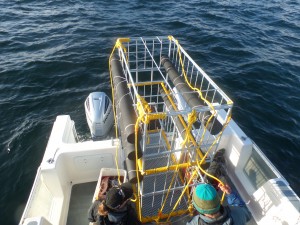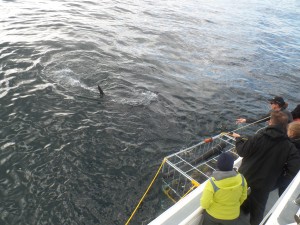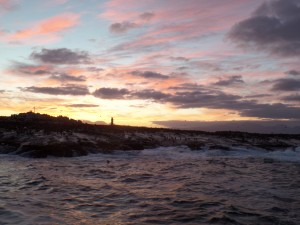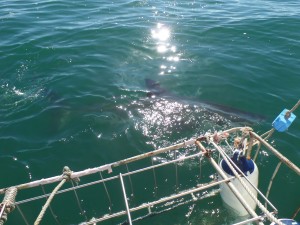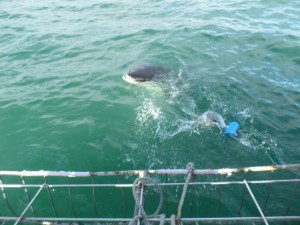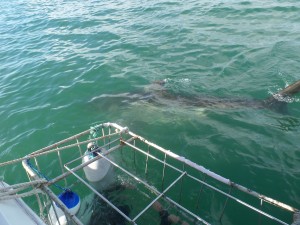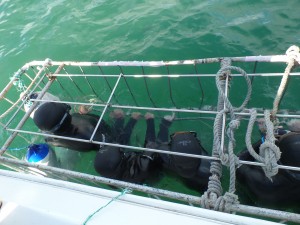If you couldn’t already tell, I love sharks! Read below to find out more about this amazing animal.
GREAT WHITE SHARKS
Dr. Nardo had the awesome opportunity to cage dive with Great White Sharks in South Africa during the summer of 2014 (their winter in the Southern hemisphere). He had fun contradicting the usual boring and unadventurous image of a mathematician.
Feel free to skip the science and mathematics temporarily in order to view the fun videos and photographs at the bottom of the page. But scroll back up to read and to start your own research!
Dr. Nardo has always been fascinated with these misunderstood creatures. They are *not* mindless eating machines; they are quite cautious when investigating new objects. The Great Whites did not rush up to the cage and try to attack the divers! They were quite aware of these funny humans in metal boxes and explored, but they were not aggressive. Here are some research-based facts about these beautiful animals.
His expedition, “The Great White Shark Trail 2014” was led by world famous photographer and naturalist Chris Fallows through his company Apex Shark Expeditions. Fallows and his wife Monique, who compiles shark statistics for their company and shares them with academic researchers, have put together a top-notch company of individuals who love their jobs; everyone at Apex cares deeply about sharks, the ocean, and our environment. Fallows has filmed Great Whites for Discovery Channel, National Geographic, and many more organizations. If you have seen one of the “Air Jaws” documentaries on Discovery Channel’s “Shark Week,” then you have likely seen his videos of Great Whites.
When we enter the sharks’ oceanic domain, we must be respectful and careful. We are their guests. Every year, there are incidents involving sharks, but the media usually hypes them out of proportion! Every few years, someone proclaims a “summer of the shark” scare-fest.
As a probability expert, Dr. Nardo certifies the claims below.
- You are far more likely to be injured by cows and other “warm and fuzzy” creatures than by a shark.
- You are far more likely to be injured in your car on the way to the beach than by a shark.
You are more likely to be injured by a falling coconut or by stumbling in the sand at the beach than by a shark. - To check out Dr. Nardo’s claims about relative risks, follow the link to the statistics compiled by the Florida Museum of Natural History at the University of Florida.
- For a less “academic” but still research-based approach, you can also explore the risk comparisons compiled by the Discovery Channel as part of its annual “Shark Week.”
There are many reputable researchers who use science to fill in our massive gaps of knowledge about these misunderstood sea creatures who are vital for the ocean’s ecosystem.
|
SCIENTIST
|
ORGANIZATION’S WEBSITE
|
FOCUS
|
|
George H. Burgess
|
Longitudinal World-Wide Data on Human-Shark Interactions
|
|
|
Ralph S. Collier
|
Great White Sharks off the Western coast of the United States
|
|
|
Dr. Mauricio Hoyos
|
Enormous Great White Sharks off Mexico’s Guadalupe Island
|
|
|
One of Dr. Hoyos’ videos of “Deep Blue” recently went viral because it shows the largest Great White Shark filmed around a shark cage. “Deep Blue” is a massive female Great White around 20 feet long! |
||
|
Dr. Robert Hueter
|
Shark Conservation in the Gulf of Mexico and the Caribbean Sea
|
|
|
Dr. Greg Skomal
|
Great White Sharks off the Eastern coast of the United States
|
|
In fact, sharks have way more to fear from us than vice versa. Each year, it is estimated that 100 million sharks are senselessly slaughtered for their fins.
You’ll never catch Dr. Nardo eating the “delicacy” called shark-fin soup! We need sharks in our oceans to keep that vital, delicate ecosystem healthy and balanced. With shark numbers decreasing very rapidly, fish populations could grow unchecked and harm the food chain of the oceans. We do not fully understand the unintended consequences that could occur from such steep declines in shark populations, but it is enough to give environmental and marine scientists pause! Check out the undercover statistics work done by Shelley C. Clarke of Imperial College London to expose the shark fin trade at Science News or the National Geographic.
Here are more pictures and videos from Dr. Nardo’s 2014 cage diving trip to South Africa with Apex Shark Expeditions:
View the video gallery below and the descriptions that follow:
- Here is an extended bait pull.
- The crew at Mossel Bay pulls up on the bait fish at the last moment to bring a juvenile Great White to the surface.
- After over an hour in the frigid water, Dr. Nardo is rewarded by a private interaction with “Barnacle Bill.” Notice the sea life clinging to his dorsal fin.
- This beauty is from False Bay in Cape Town, South Africa. It is beautiful despite the thin plastic packing tape wrapped around its body at the gills. Hopefully the plastic will eventually weaken and snap off before doing long-term damage to the shark’s breathing system. For not only Great Whites but also other sea creatures, please think twice about how you discard plastic drink “six pack” binders and other plastics.
- Notice the orderly fashion by which these two Great Whites from Mossel Bay greet one another. It’s not all fins and teeth.
- Notice the mangled dorsal fin on this Great White. Perhaps the fin was damaged by another shark or by interaction with humans. Perhaps it was a birth defect or medical issue. In any event, the shark does not seem to have mobility issues.
- A Great White lunges at the surface to go after the bait fish.
- Wait for the quick head breach at the end! The Great White is one of the only sharks known to routinely stick its head out of the water.
- Pretty Good for a Mathematics Professor!
- A juvenile Great White chases a bait fish by the cage. Petey the Petrel gets a bird’s eye view!
- Contrary to its mischaracterization as “frenzied,” this Great White peacefully swims past the cage.
- Here is another video of the seal’s outmanuevering of the shark.
- The adult Great White’s preferred food in South Africa is seal. The shark launches itself vertically out of the water and breaches the surface. It is like a Polaris missile, and so this is called a Polaris Breach. Watch any of the “Air Jaws” documentaries on Discovery Channel to see this breaching behavior. The odds are in the shark’s favor before it leaves the water, but then the odds turn to the agile seals if the shark’s initial strike fails. The success rate for the shark is approximately 50%. Though we did not see the breach, we did see the chase afterwards. This lucky seal escapes!
- After a day in the water, the cage starts to creak spookily. Luckily, a Great White provides a burst of adrenaline.
- Here are Dr. Nardo and Petey the Petrel after getting out of the frigid winter water.
- Check out the turning radius on this Great White! You can hear encouragement from everyone on board the boat, including our expedition leader Chris Fallows. You can do it, shark!
- Petey the Petrel gets an extended look at a juvenile Great White (about 9 feet).
- Dr. Nardo needs a helping hand to get out of the cage. He just missed seeing the last shark of the day.
- It takes a little bit of time to get used to being in the cage. The cold water and washing machine type of motion are a little disorienting. But if the abysmal sailor Dr. Nardo can do it, you can too!

